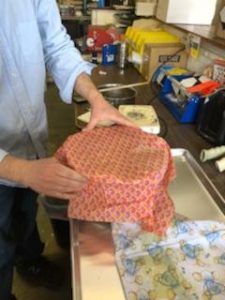
Making reusable food wraps is a fun and easy project to do that will help reduce our use and reliance on plastics. But besides that, reusable food wraps just have an adorable, old-fashioned, back-to-basics DIY charm to them. While you will love using your wraps, they will invite interested comments from anyone who sees them.
Items You Need
100% Cotton fabric (very thin and tightly woven)
Pine Rosin
Optional accessories: tongs or clothespins, parchment paper or newsprint, cooking tray, buttons and thread.
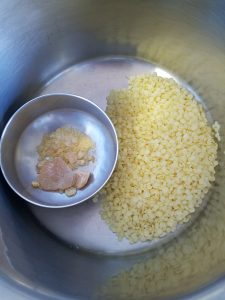
Measuring your proportions: I have found that using a mix of 90% Beeswax to 10% pine rosin (Brazilian or Honduran) works nicely. As you will see in the photos, the resulting cloth is tacky enough so that when you fold it the fabric sticks to itself. The easiest way to weigh out percentages like this is weigh your material in grams instead of ounces. So, for example, when I did this project, I decided to that the total weight of the material should be 200 grams. 10% of 200 equals 20. So I measured out 20 grams of pine rosin. The remaining 180 grams would have to be the beeswax. With a mixture totaling 200 grams, I treated 3 pieces of fabric measuring 18 x 21 inches.
[Side note: use pine rosin lumps or flakes. Do not use rosin powder. To keep pine rosin powder from clumping, magnesium carbonate is added–usually 15%. You want to make a beeswax-rosin mixture without magnesium carbonate included.]
First step: choosing your fabric. Choose a 100% cotton fabric that is tightly woven. You can find good fabric at a fabric store, craft store, or even Walmart. I found Walmart to be convenient because in addition to the option of having fabric cut from a bolt, they also had 18 x 21 inch pre-cut pieces available for only $0.97! Since your fabric will be saturated in wax, I don’t believe it is necessary to pre-wash it.
Next measure out the size you want the fabric to be. For example, if you have a large mixing bowl you often use for marinating, measure out how large the fabric will need to be to cover it. Likewise, if you are planning to make cloth wraps for holding sandwiches, it would be a good idea to figure out first the right dimensions for the fabric. A good way to do this is with an actual sandwich and some paper for practice (just like wrapping holiday gifts!).
To treat the fabric, you will need to melt the beeswax, rosin, and oil together in a container. You will not want to use one of your regular cooking pots or pans. So, perhaps a good idea is to see if you can find a pot or pan at a garage sale or thrift store for a couple bucks. For projects like this, it is usually recommended to use a double boiler. The reason for this that it is easier to heat the materials gradually without burning them, and also it is a little safer. If you can find a double boiler, great. If not, that is okay, because you can still do this project. You just have to pay attention and watch closely.
I will assume you do not have a double boiler. In this case, put the materials in your pot and set the heat low. The danger is that these materials are flammable. If you use high heat, they may smoke and catch on fire. So as long as you keep the heat on low and watch closely the entire time, you should be okay. As the materials melt, stir them carefully (without splashing or spilling) to make sure they are fully mixed and incorporated. The rosin has a much higher melting point than the beeswax. It is not unusual for there to be unmelted portions of rosin visible while all the beeswax is melted, particularly if the rosin is in large chunks. Therefore, it is a good idea to crush the rosin into small pieces beforehand to make melting quicker and easier. After the material is melted, you should remove the pot from the stove for safety. If you accidentally spill wax on the stove, it will be a fire hazard next time you cook.
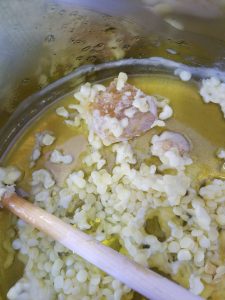
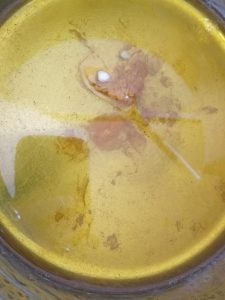
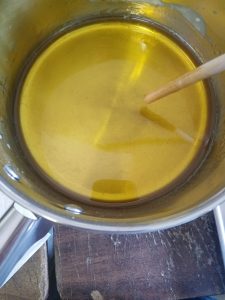
Next, place your piece of fabric into the wax-rosin mixture. Your goal is to make sure that all areas of your fabric are saturated. If your fabric is large and your pot is relatively small, you can actually fold the fabric before putting it into the mixture. The wax-rosin liquid if hot and will saturate the fabric.
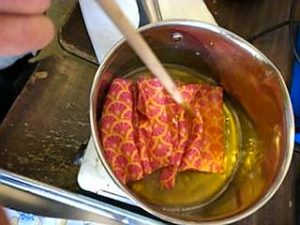
You have to work quickly because the wax can cool and harden rapidly. Use tongs or clothespins to remove the fabric. Hold it up so it can drip. Drip it into the pot or onto a piece of parchment paper. Hang to dry, or lay flat on parchment paper or tray.
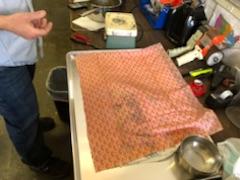
The rosin in the formula serves to make the fabric a little more tacky so it will stick together when you fold it. When your fabric is newly made, you may find it more tacky than to your liking. With some use, it will become less tacky.
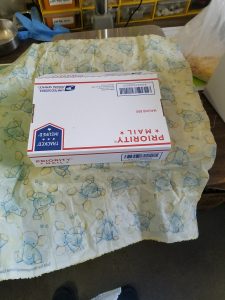
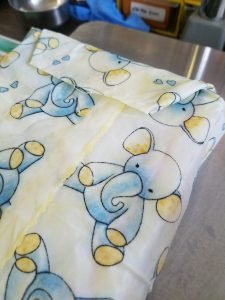
One optional extra step
When I researched this idea, I saw one person present the idea of sewing on 2 large buttons. The purpose was to make sure that the wrap stayed closed. As an example, you would not want the wrap holding your sandwich to fall open. The remedy would be that your fabric would be cut to hold the sandwich. On each end, where the fabric is folded up, there would be a button sewn on. To keep the 2 flaps from opening up, a string or piece of twine is run between the two buttons to hold the flaps in place.
Is this necessary? I thought it looked nifty, but it may not be needed. After you have made your wrap, see hold well it holds on its own. The wraps I made hold well enough that they don’t need anything extra.
Taking Care of Your Wrap
To clean your new wrap, all you really need to do is rinse it in cold water and gently wipe it. Use of detergent and scrubbing can result in loss of wax thereby reducing your wrap’s effectiveness. You can spray or dowse with isoprophyl alcohol to eliminate germs. Be sure to dry completely before use.
http://www.chemicalstore.com is a reliable supplier for beeswax and pine rosin.
